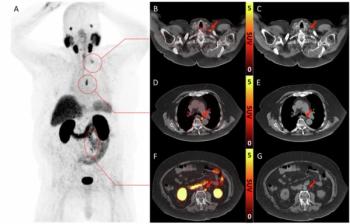
Number of FDA clearances slides in June to just 20
June was an off month for FDA clearances. Only six of the cleared devices acquire original image data: an MR scanner, an ultrasound system, a CT scanner, and three radiographic or radiographic/fluoroscopic products. The rest were upgrades to existing
June was an off month for FDA clearances. Only six of the cleared devices acquire original image data: an MR scanner, an ultrasound system, a CT scanner, and three radiographic or radiographic/fluoroscopic products. The rest were upgrades to existing systems, peripheral devices, or software packages.
Even the number was disappointing. Just 20 devices cleared the regulatory agency in June. This compares poorly with the 27 clearances issued in May. June had the lowest number of radiologic devices cleared since the agency passed 18 devices in January 2001. (For the past three years, January has been the slowest month for FDA clearances.)
June’s shortfall, however, might not have been the fault of regulators. The average time of review-the time from submission to final decision-was within or very close to the 90-day period afforded FDA reviewers by Congress. The lull, therefore, may have been the result of a slowdown in submissions.
Of the 20 products cleared in June for marketing in the U.S., five were in radiotherapy, four in ultrasound, three each in CT and x-ray, two each in MRI and image management, and one in nuclear medicine. Notable was Ultrasound Scanner Type 2102 from B&K Medical A/S. The scanner, which the FDA determined to be substantially equivalent to Siemens’ Sonoline Elegra, supports B- and M-modes, pulsed-wave Doppler, and color flow mapping, as well as tissue harmonic imaging. Optionally, an ECG signal can be superimposed on the ultrasound information in all modes and mode combinations. The 2102, which cleared on June 8, can perform simple geometric measurements, as well as calculations involving vascular, urological, cardiological, and ob/gyn applications. It can also be used to guide biopsy and puncture needles. The system was cleared with four transducers-models 8660, 8664, 8804, and 8805-providing a range of capabilities pertaining to ophthalmic, fetal, cardiac, and peripheral vessel imaging. Transducers are linear, convex, and mechanical sector.
Fonar’s Pinnacle was similarly impressive. The MR scanner is identical to the Fonar Quad 12000 four-post magnet system, except that the resistive magnet coils are replaced with superconductive magnet coils. The poles are arranged to establish a 0.6-tesla magnetic field with a limited fringe field. The signal-to-noise ratio is equivalent to the SNR of the Quad 12000. The open design of Pinnacle, which was cleared June 6, allows it to be used to guide interventional procedures. The scanner provides a considerable increase in magnet stability, according to the company, resulting in enhanced image quality and a major reduction in operating costs. Another advantage, according to Fonar, is the improved overall reliability due to the elimination of equipment commonly used for resistive magnets.
MRI
- Cardiac View 2001 Surface Coil (Cardiac MRI, a Magna Lab subsidiary; June 8). The receive-only coil provides close proximity to the anatomy to be imaged, namely the heart and thoracic structures. The product is designed for use with GE’s Signa CV/i 1.5-tesla MR scanner.
Ultrasound
- Acuson Cypress System modification (Acuson; June 27). The modification, described in Acuson’s FDA application as “minor,” supports the use of an additional transducer, the AcuNav Diagnostic Ultrasound Catheter, a single-use, disposable, steerable, ultrasound-tipped catheter device for imaging the vasculature and right heart. The transducer was previously cleared for use with Acuson’s Aspen and Sequoia systems. When used with the AcuNav, Cypress will allow intravascular and intracardiac imaging, specifically the visualization of vascular, cardiac, and great vessel anatomy.
- Model IO-3DUIMS (Virtual Probe) (IODP ; June 13). The add-on accessory to an ultrasound scanner acquires, analyzes, stores, and retrieves ultrasound data for 3-D processing. The system records the position and movement of transducers, assembling 2-D images over a volume. It was judged substantially equivalent to the EchoTech 3D FreeScan.
- Thin-Film Dressing (Martin E. Wendelken; June 20). The dressing provides a temporary cover to protect an area of anatomy during an ultrasound exam. It protects normal skin; clean, closed surgical incisions; skin grafts; superficial wounds; chafed skin; and pressure ulcers.
Radiotherapy
- BrachySeed Pd-103 (Draximage; June 25). The single-use seeds are designed for permanent interstitial implantation to treat selected localized tumors of the head, neck, lung, pancreas, breast, uterus, and prostate. They may be used as a primary treatment or to treat residual disease after excision of primary or recurring tumors. They may also be used in combination with external-beam radiation.
- Breast Board (Arplay Medical; June 8). The accessory is designed for use during linear accelerator treatment or CT simulation. The board is composed of a fixed-base plate attached to a tiling board upon which the patient lies. The product is made of carbon fiber, providing an attenuation factor of less than 1% for radiation at 18 MeV or above.
- QED diode detectors model 1112-1116 (Sun Nuclear; June 6). Clearance covers a series of five models designed to detect photon and electron beams of varying energy ranges. The detectors are intended as in vivo verification tools for dose delivery to the patient during radiation therapy.
- Helax-TMS Proton Functionality (MDS Nordion; June 5). The system supports 3-D treatment planning for radiation therapy delivered by external beam or brachytherapy. The user selects from a menu of dose calculation tools, depending on the type of radiation: a convolution/superposition pencil beam or a collapsed cone algorithm for photons, a gaussian pencil beam model for electrons, or a dose calculation algorithm for protons. The product also offers a module for modeling interstitial and intracavity brachytherapy.
- PTW Dosimetry Diode (PTW-New York; June 20). The dosimetry diode measures the dose delivered to the patient by high-energy photon beams. Applications include stereotactic beams, IMRT (intensity-modulated radiation therapy), water phantom scanning, and mapping dose distributions from brachytherapy.
CT
- MX 8000 v5.0 (Marconi; June 15). Version 5.0 represents the company’s next iteration of advances for its flagship multislice scanner.
- Cardiocam Model 9CSY0799 (Danish Diagnostic Development; June 8). No additional information available.
- CT/Master 1.0 (Columbia Scientific; June 27). The software processes CT dental scans to aid clinicians in planning the placement of dental implants.
Nuclear Medicine
- QGS/QPS programs (Digirad; June 15). The programs-one providing quantitative gated SPECT (QGS), the other quantitative perfusion SPECT (QPS)-are stand-alone software applications developed by Cedars-Sinai Medical Center. They are intended for use on the Digirad 2020tc SPECT to display and quantify myocardial perfusion and functional parameters from cardiac SPECT data.
Image Management
- LifeJet Printer 400 (Ferrania; June 8). The inkjet printer produces color and gray-scale referral medical images on paper. The system was judged substantially equivalent to the Kodak Digital Science 1200.
- Syngo Multimodality Workstation (Siemens Medical; June 26). The workstation is designed for image display, manipulation, 3-D reconstruction and storage of medical images for all digital modalities, including digital x-ray and dental images. It can be configured as a satellite console, sharing the patient database with the main console of a CT, MRI, or radiographic/fluoroscopic (R/F) imaging system, as well as a stand-alone diagnostic review and postprocessing workstation.
X-Ray
- Q-Rad Radiographic System (Quantum Medical Imaging; June 20). The stationary system is designed to obtain radiographic images.
- Expedio 500DR/F system (GE Medical; June 8). The stationary system consists of an x-ray generator, angulating table with x-ray tube, collimator and image intensifier, wall stand, overhead tube suspension, operator console, and digital archive system. It is designed for R/F exams.
- Ziehm Vision (Ziehm; June 20). The mobile C-arm is designed for R/F exams, including a range of surgical intervention or guidance procedures requiring x-ray imaging in and outside of the operating room. Radiographic films can be produced using an accessory cassette attached to the image intensifier.
Newsletter
Stay at the forefront of radiology with the Diagnostic Imaging newsletter, delivering the latest news, clinical insights, and imaging advancements for today’s radiologists.






























